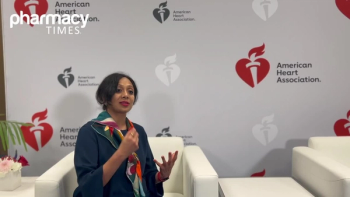
Hepatitis C: Addressing the ‘Silent Syndemic’ and Improving Access to Care
Lindsey P. Sheehan, PharmD, MPA, MBA, discusses ongoing challenges of diagnosing and treating hepatitis C, emphasizing its increased incidence among younger populations and ongoing low rates of diagnosis.
Hepatitis C has been called the “silent syndemic” because many people with the disease are unaware of their infection, explained Lindsey P. Sheehan, PharmD, MPA, MBA, a PGY2 pharmacy resident - specialty pharmacy administration and leadership, University of Kentucky HealthCare, during a presentation at the American Society of Health-System Pharmacists (ASHP) Pharmacy Futures 2024 in Portland, Oregon.
“We call it the ‘silent syndemic’ really because, in a lot of places across the United States, hepatitis C was a huge area of focus for the baby boomer generation,” Sheehan said. “As more of those patients were identified and treated, in a lot of people's minds, hepatitis C became less and less of a problem and went away. Unfortunately, that's not the case.”
Sheehan explained that hepatitis C incidence has actually increased in a much younger patient population (aged 20-39 years) that typically has trouble accessing the health care system. In this patient population, the primary mode of transmission is through intravenous substance use.
Sheehan explained further that hepatitis C is a viral infection of the liver hepatocyte. Currently, there is no vaccine available for prevention of hepatitis C, unlike hepatitis A and hepatitis B. However, there are well-tolerated, curative treatments available. Patients with hepatitis C can have both an acute and chronic presentation, although the disease is commonly asymptomatic, so it remains rare for a patient to have acute onset of hepatitis C and know that they are actively infected, according to Sheehan.
“Like I've mentioned, [hepatitis C] is most common among people who inject drugs, and most importantly, it is curable. We've come a long way from the ribavirin and interferon era, if those are the therapies that you're most familiar with for treating hepatitis C,” Sheehan said. “Really what we know is that treatment can be very simple. In particular, [this is true] for patients who are treatment naive, who don't have cirrhosis, or who have compensated cirrhosis.
For treatment-naive adults without cirrhosis or with compensated cirrhosis, Sheehan explained that the current treatment is glecaprevir/pibrentasvir (Mavyret; AbbVie Inc) at 3 tablets by mouth (taken with food) once daily for 8 weeks, or sofosbuvir/velpatasvir (SOF/VEL, Epclusa; Gilead Sciences, Inc) at 1 tablet by mouth (taken with or without food) once daily for 12 weeks. For SOF/VEL, genotype 3 infection with compensated cirrhosis, NS5A RAS testing is recommended, according to Sheehan. If baseline NS5A RAS Y93H is present, the American Association for the Study of Liver Diseases and the Infectious Diseases Society of America guidelines recommend adding weight-based ribavirin or choosing another recommended regimen.
“Despite the relative ease of treatment, compared to historic states, as well as our knowledge of hepatitis C, it still is having a continued impact from a public health perspective,” Sheehan said. “It remains the leading cause of liver cancer and cirrhosis-related death in the United States, with over 5 million people actively infected and about 45% to 85% of those patients undiagnosed.”
Additionally, incidence of hepatitis C has doubled since 2013 in the United States, according to Sheehan. The highest risk patients are those who are young and those who inject drugs.
“We see this impact continue in our mortality rates,” Sheehan said. “On the West Coast and in the Northeast, [rates are] declining faster than the national average. But we see that in the South, and in particular in my home state of Kentucky, [rates] are actually increasing compared to the national average. So, we still are seeing a lot of mortality associated with this disease.”
The CDC and the World Health Organization (WHO) in response to these rising mortality rates has published a plan to eliminate hepatitis C by 2030 in the United States. The plan stipulates that this effort starts with a universal screening recommendation for all adults, regardless of risk factors.
“All adults are recommended to be screened for hepatitis C, at least once per lifetime, and at least once per pregnancy,” Sheehan said. “[The CDC and WHO] also recommend risk-stratified routine screening for people with risk factors, [which includes] patients who inject drugs, and patients who have other medical conditions and may, for example, receive routine maintenance hemodialysis.”
If this public policy initiative from the CDC and WHO works, Sheehan noted that it would be possible to make a strong impact on both disease burden of hepatitis C and prevention of cirrhosis.
“These will prevent that downstream consequence of hepatocellular carcinoma [HCC], as well as hepatitis–associated extrahepatic manifestations, such as lipodystrophy, type 2 diabetes, cirrhosis, and other manifested complications,” Sheehan said.
Sheehan noted that the economic impacts are also significant.
“It's estimated for the downstream consequences of hepatitis C, HCC, and cirrhosis, we spend about $6 to $10 billion annually in the United States, and that's primarily Medicaid dollars. A single course of hepatitis C treatment costs between $20,000 and $30,000, and it's estimated that treatment can save $15,000 to $25,000 per patient per year of life after cure,” Sheehan said. “For curing a 25 year old patient, since we know that our patients are typically younger, you really have strong economic impact.”
However, although there is a clear treatment pathway that is becoming more and more accessible and state and government support to cure this disease, reported acute cases or identified cases have not kept pace with estimated acute infections.
“So, we're not doing a great job of identifying these cases,” Sheehan said. “We're also not doing a great job of treating these patients, as hepatitis C treatment actually declined from 2015 to 2020.”
Sheehan noted that with these data showing diagnostics and rates of treatment are not catching up as quickly as they should given the available treatments and public health support, it may be necessary to think about the designed barriers that are currently present in the health care system that are causing these ongoing challenges.
“We know this is a highly prevalent disease with a well-tolerated, curative treatment available. Most insurance treatment barriers have been eliminated as far as payer requirements for patients who have insurance,” Sheehan said. “We really need to look at the system, and how we can improve the system to get patients connected to care.”
REFERENCE
Sheehan LP. Advancing Hepatitis C Treatment: The Role of Specialty Pharmacists in Innovative Care Paradigms. American Society of Health-System Pharmacists Pharmacy Futures 2024; June 8-12; Portland, Oregon.
Newsletter
Stay informed on drug updates, treatment guidelines, and pharmacy practice trends—subscribe to Pharmacy Times for weekly clinical insights.















































































































































































































